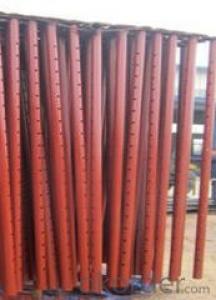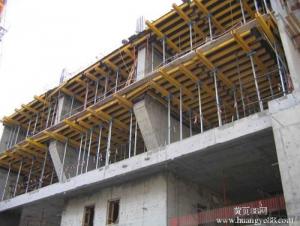telescopic props scaffolding props steel props
- Loading Port:
- China Main Port
- Payment Terms:
- TT OR LC
- Min Order Qty:
- -
- Supply Capability:
- -
OKorder Service Pledge
OKorder Financial Service
You Might Also Like
Quick Details
| Model Number: | |||||
| Type: | Scaffolding Part Type: | Material: | |||
| Surface treatment: | Color: | Technique: | |||
| Length: | Inner tube diameter: | Outer tube diameter: | |||
| Thickness: | Application: | Certification: |
Packaging & Delivery
| Packaging Detail: | 1.props scaffolding props steel props is in a bundle with a wire which is in bare package. 2.One 20 GP container can load almost 1500-2000 pieces of props. |
| Delivery Detail: | 10-20 days after deposit |
Specifications
props scaffolding props steel props
1.For slab supporting
2.CO2 arc welded technique
3.High loading capacity
4.Rust-proof
Features
1. One pieces of props scaffolding props steel props consists of internal tube, external tube, prop nut, base plate, and top plate.
2. props scaffolding props steel props can be adjusted to any length within its range which is convenient for using.
3.With its simple structure, props scaffolding props steel props is easy to assemble and dismantle which can help to save your time, labor, and cost.
4.We have several kinds of props scaffolding props steel props which are Middle East type props scaffolding props steel props , Spanish props scaffolding props steel props and Italian type props scaffolding props steel props . They are popular in Africa,South America,South Asia, and Asia etc.
5. props scaffolding props steel props is for supporting concrete slab, beam, timber, and formwork which is strong and reliable for interior building construction.
6.We can weld the flat plate or the flower plate at the top of the props scaffolding props steel props as your requirement.
SpecificationsChina)
| Product | Model | Specifications |
props scaffolding props steel props | Inner tube diameter |
40/48mm |
| Outer tube diameter |
48/56/60mm | |
| Tube thickness |
1.8/2.0/2.2/2.5/3mm | |
| Adjustable length | 1600-2900mm 1800-3200mm 2000-3600mm 2200-4000mm |
- Q: What are the factors to consider when selecting steel props?
- When selecting steel props, there are several factors that need to be considered to ensure the right choice is made. Firstly, it is important to consider the load capacity of the steel props. The load capacity refers to the maximum weight that the props can support. This is crucial as using props with a lower load capacity than required can lead to safety hazards and structural failures. Secondly, the height adjustment range of the steel props should be considered. The height adjustment range determines the minimum and maximum height that the props can be adjusted to. It is important to select steel props with a suitable height adjustment range to ensure they can be used for various construction purposes. Another factor to consider is the material quality of the steel props. It is important to choose steel props made from high-quality materials that are durable and resistant to corrosion. This ensures that the props will have a longer lifespan and can withstand the harsh construction environment. The ease of use and installation of the steel props should also be taken into account. Selecting steel props that are easy to handle and install can save time and effort during construction projects. Furthermore, the stability and rigidity of the steel props should be considered. It is important to choose props that are stable and rigid enough to provide adequate support and minimize any potential wobbling or bending. Finally, the cost-effectiveness of the steel props is an important factor to consider. It is essential to balance the quality and features of the props with their cost to ensure they provide value for money. In conclusion, when selecting steel props, factors such as load capacity, height adjustment range, material quality, ease of use and installation, stability, rigidity, and cost-effectiveness should all be carefully considered to make an informed decision.
- Q: How do you prevent rust on steel props?
- To prevent rust on steel props, there are several preventive measures you can take: 1. Apply a protective coating: One effective way to prevent rust on steel props is by applying a protective coating. This can be done by using a high-quality paint or primer specifically designed for use on metal surfaces. Make sure to clean and dry the props thoroughly before applying the coating to ensure proper adherence. 2. Use galvanized or stainless steel props: Galvanized or stainless steel props have a higher resistance to rust compared to regular steel. Galvanization involves applying a layer of zinc to the steel, which acts as a protective barrier against rust. Stainless steel, on the other hand, contains chromium that forms a passive oxide layer, preventing corrosion. 3. Keep the props dry: Moisture is a common catalyst for rust formation. Ensure that the steel props are kept dry and avoid exposing them to excessive humidity or water. If the props come into contact with water, promptly dry them to prevent rust from forming. 4. Regular cleaning and maintenance: Regularly clean the steel props to remove any dirt, debris, or other contaminants that may promote rust formation. Use a mild detergent or a metal cleaning solution and a soft brush or cloth to clean the props thoroughly. After cleaning, dry them completely before storing or using them. 5. Store the props properly: When not in use, store the steel props in a dry and well-ventilated area. Avoid storing them in damp or humid environments as this can accelerate rust formation. Additionally, consider using moisture-absorbing products like silica gel or desiccants in the storage area to reduce humidity levels. 6. Inspect for damage: Regularly inspect the steel props for any signs of damage, such as scratches, dents, or chipping of the protective coating. Promptly repair or replace any damaged props to prevent rust from spreading. By following these preventive measures, you can significantly reduce the risk of rust formation on steel props, ensuring their longevity and functionality.
- Q: Are steel props adjustable in both horizontal and lateral directions?
- No, steel props are typically adjustable in only the vertical direction.
- Q: Can steel props be used in the construction of libraries?
- Yes, steel props can be used in the construction of libraries. Steel props, also known as adjustable steel props or steel scaffolding, are commonly used in construction projects to provide temporary support to structures. They are designed to bear heavy loads, making them suitable for supporting the weight of library structures and the load of books and other materials. Steel props are adjustable in height, allowing for flexibility during the construction process. Furthermore, steel props are durable, corrosion-resistant, and can be reused in multiple construction projects, making them a cost-effective choice. Overall, steel props can be safely and effectively used in the construction of libraries to provide structural support and enhance the overall safety and stability of the building.
- Q: Can steel props be used for supporting temporary military structures?
- Yes, steel props can be used for supporting temporary military structures. Steel props are commonly used in construction and can provide strong support for various types of structures, including temporary military installations. Their durable and sturdy nature makes them suitable for handling the weight and load requirements of military structures, ensuring their stability and safety.
- Q: Can steel props be used for supporting temporary roofs?
- Indeed, temporary roofs can be supported using steel props. Acrow props, also referred to as adjustable steel props, are frequently employed in construction endeavors for the purpose of providing temporary support to various structures. Their height adjustability renders them perfectly suitable for supporting temporary roofs of varying dimensions and configurations. The robust and long-lasting characteristics of steel props guarantee their ability to withstand the weight and maintain stability of the roof structure. Furthermore, the installation and removal of steel props can be accomplished with ease, thus rendering them a practical and effective solution for temporary roof support.
- Q: Are steel props resistant to impact or vibration?
- Both impact and vibration are generally resisted by steel props. Due to its strength and durability, steel is able to endure substantial impact forces without any harm. Furthermore, steel possesses a high natural frequency, enabling it to efficiently absorb and disperse vibrations. Consequently, steel props are deemed highly suitable for situations where resistance to impact and vibration is crucial, such as in construction, scaffolding, and temporary support structures. Nevertheless, it is important to acknowledge that the precise impact and vibration resistance of steel props may differ based on their individual design, quality, and installation.
- Q: Basement slab reinforcement drawings did not explain how to calculate the final accounts?
- If at that time a list of instructions is to reduce the standard, according to the actual settlement.
- Q: Are steel props suitable for supporting temporary scaffolding towers?
- Indeed, steel props prove to be an apt choice for bolstering temporary scaffolding towers. Referred to as adjustable steel props or acrow props, these props enjoy extensive usage in the construction sector, where they temporarily fortify structures such as scaffolding towers. Their primary purpose is to furnish stability and bear the weight of scaffolding systems, thereby guaranteeing the well-being of workers and the durability of the edifice. Steel props exhibit the ability to be adjusted in height, rendering them effortlessly installable and adaptable to accommodate diverse scaffolding tower dimensions. Moreover, their robust construction and remarkable load-bearing capacity establish them as a dependable option for supporting temporary scaffolding towers.
- Q: Are steel props suitable for supporting temporary exhibition or display structures?
- Yes, steel props are generally suitable for supporting temporary exhibition or display structures. Steel props, also known as adjustable steel props or acrow props, are commonly used in the construction industry for temporary support of structures. They are designed to provide stability and load-bearing capacity, making them ideal for supporting temporary exhibition or display structures. Steel props are adjustable in height, making it easy to customize the support according to the specific requirements of the exhibition or display structure. This flexibility allows for quick and easy installation, as well as adjustments during the setup process. Furthermore, steel props are known for their strength and durability. They are made from high-quality steel, which provides excellent load-bearing capacity. This ensures that the exhibition or display structure is properly supported and can withstand the weight of the objects or materials it holds. In addition to their strength and adjustability, steel props also offer stability. They have a wide base and a sturdy design, which helps to prevent any movement or instability of the supported structure. This is particularly important for temporary structures, as they may be subject to various forces or vibrations during the exhibition or display. Overall, steel props are a reliable and suitable option for supporting temporary exhibition or display structures. Their adjustability, strength, and stability make them an ideal choice to ensure the safety and stability of the structure and the objects or materials being displayed.
Send your message to us
telescopic props scaffolding props steel props
- Loading Port:
- China Main Port
- Payment Terms:
- TT OR LC
- Min Order Qty:
- -
- Supply Capability:
- -
OKorder Service Pledge
OKorder Financial Service
Similar products
Hot products
Hot Searches
Related keywords

























